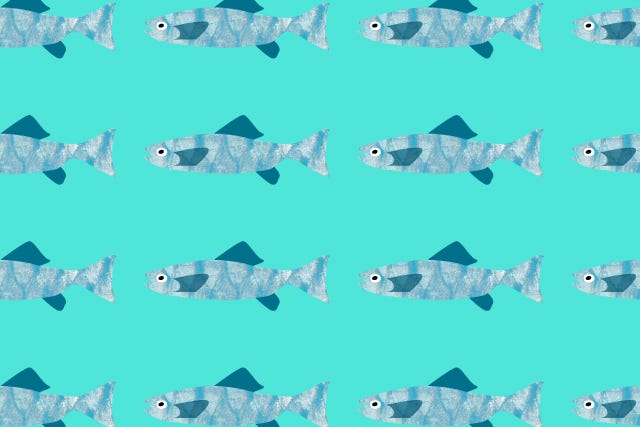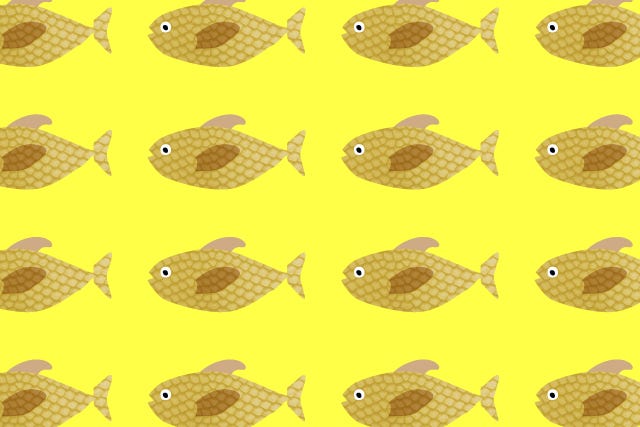How to Make a Fish Farm in Minecraft
 Illustrated by Sydney Hass.
Illustrated by Sydney Hass.
In terms of healthy eating, it seems there's one food most experts can agree on: fish. After that, the gloves come off, particularly with regard to the issue of wild caught verses farm raised. Is there a definitive best practice? It turns out there's pros and cons to both. We talked to the experts to demystify the fish issue and find out what exactly you need to know before chowing down.
The great debate
To some, eating a farm-raised fish is no better than eating a beakless chicken grown in a science lab. The argument is that the antibiotics, pesticides, and artificial dyes used by some fisheries produce fish that are not only nutritionally inferior – containing more fat and more pro-inflammatory omega-6 fatty acids – but downright dangerous to eat. According to Peter Bridson, Aquaculture Research Manager at Monterey Bay Aquarium's Seafood Watch, the brouhaha over farmed fish began back in 2003, with a controversial report from the Environmental Working Group that showed farmed salmon in U.S. grocery stores contain 16 times more of the potentially cancer-causing polychlorinated biphenyls (PCBs) than their wild counterparts.
However, if all these arguments aren't enough to make you bust out your picket sign, take a second to consider this: "Wild caught" is a broad term that can include destructive fishing methods such as dynamiting reefs, high-seas bottom trawling, and drift netting.
Additionally, it's estimated that nearly 85% of the world's fisheries are either fully fished or over-fished. There's simply not enough wild fish to satisfy demand, says Bridson, and many believe farmed fish is the answer. "Buying into the mantra 'farmed bad, wild good' cuts in half our only hope of saving the wild stocks," says Tim O'Shea, co-founder of CleanFish, an organization dedicated to sourcing the world's best fish – both wild and farm-raised. According to O'Shea and Bridson, if we want to keep eating fish, we have to take the pressure off wild species by supporting legitimate, well-run aquaculture.
 Illustrated by Sydney Hass.
Illustrated by Sydney Hass.
The progress
Is there such as thing as legitimate, well-run aquaculture? Yes. O'Shea likens small-scale artisanal fish farming to any other kind of farming, stating that coastal people have been practicing responsible aquaculture for centuries. The problem, as with other kinds of farming, came when fish farms began producing on a large scale for commercial export. "You can't apply the factory system to living things," says O'Shea.
Like the farms that are working to bring grass-fed beef and pastured pork and poultry to market, there are fisheries doing the same thing — raising fish in closed, floating pens so they can filter wastes; working to eliminate antibiotics; and developing nutritionally equivalent plant-based fish feeds. It's the mission of CleanFish to connect artisan fishermen and farmers with distributors and consumers, and build the market for responsible fish.
Since that incendiary study in 2003, organizations like the World Wildlife Fund (WWF) and the Dutch Sustainable Trade Initiative (IDH) have been working to wrangle the industry as a whole. In 2010 they founded the Aquaculture Stewardship Council (ASC), an independent, non-profit created for the express purpose of developing and managing global sustainability standards for shellfish and finfish aquaculture. ASC standards cover every aspect of fish farming: water quality, feed composition, escapees, antibiotics, biosecurity, energy consumption, greenhouse gas emissions, worker wages, and transparency. Farms that meet the standards receive ASC certification, indicated by a little green label you can look for when trolling the fish isle.
 Illustrated by Sydney Hass.
Illustrated by Sydney Hass.
What to buy
Instead of going by "wild-caught" verses "farm-raised," the general consensus from Bridson, O'Shea, and both the Marine Stewardship Council and the WWF, seems to be: shop by sustainability. This is defined by Seafood Watch as "being from sources, either fished or farmed, that can exist over the long-term without compromising species' survival or the heath of the surrounding ecosystem."
Those behind CleanFish, Seafood Watch, and the ASC encourage everyone to use the guides, check labels, and ask questions like, Where is the fish is from? How was it raised? How was it caught? And, what was it fed? Although your waiter or fishmonger might not know the answer, O'Shea says we're voting with these questions. When consumers start showing there's a market for responsible seafood, the industry – the whole industry – will follow the money.
So, although it might take a bit more investigative effort and possibly more dollars, when you shop sustainably, you can tie on your salmon bib and dig in with peace of mind knowing you're eating for two now – you and Mother Earth.
How to Make a Fish Farm in Minecraft
Source: https://www.refinery29.com/en-us/difference-between-wild-and-farmed-fish